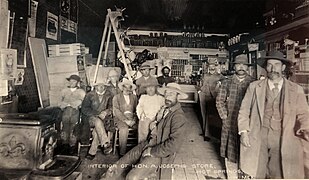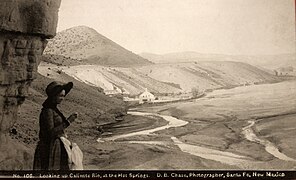Ojo Caliente Hot Springs
History
The hot springs were used by prehistoric people, according to James A. Caufield.(Caufield 1985:8-1) Later, the springs were used by the ancestral Native Pueblo peoples for generations before the Spanish arrived in the area. It has been written that the Tewa hero P'oseyemu accessed the underworld via the sacred warm water springs. The original place name is Posi or P'oseuinge which roughly translates to "village at the place of the green bubbling hot springs". The Puebloan village housed more than 1,000 people and contained numerous structures. It is thought to have been abandoned in the 16th century due to an epidemic. Other Native peoples used the springs as well, including distant tribes such as the Navajo, Commanche and the Ute.
Early Spanish colonizers, including Coronado's soldiers, soaked in the healing water. In 1534, the Spanish colonizer Cabeza de Vaca visited the springs and named them Ojo Caliente. It is thought that before the 1680 Pueblo Revolt, Spanish colonists used the springs. In 1793, the Ojo Caliente Land Grant was signed by Governor Fernando de la Concha; the document approved settlers including Luis Duran and José Antonio Espinosa and 52 other settlers. In 1807, Duran traveled with Spanish soldiers during the colonial period where he encountered Zebulon Pike who referred to the springs as a "natural curiosity". The hot springs were first recorded in geologic publications in 1875.
A bathhouse was constructed in 1860 by the Taos native, Antonio Joseph and his wife. The Mission Revival style building was built with thick adobe walls and rough-hewn viga roof beams. In 1868, the Joseph's opened the hot springs as a natural health spa. Another account states that Joseph opened the resort in 1880. The anthropologist, Nancy Owen Lewis writes in her book, Chasing the Cure in New Mexico, that Ojo Caliente hot springs had lodging for 60 people by 1880, and that the resort attracted hundreds of individuals who soaked in the mineral waters for rheumatism, kidney problems as well as skin problems.(Lewis 2016:21)
In 1881, rail service to the area provided by the Denver and Rio Grande Railroad connected to a stage coach stop ten miles from the springs.(Lewis 2016:21) The town of Ojo Caliente grew up around the springs providing lodging, a general store and a post office. After Antonio Joseph died in 1910, his family further developed the property as well as bottled and sold mineral water from the springs. While the springs originally accepted those with tuberculosis in 1903, by 1910, the resort published advertisements stating "People with consumption...are not accepted".(Lewis 2016:159, 272)
In 1916, a hotel was constructed on the site. In 1924, Anthony Joseph, a relative of Antonio Joseph, and his wife constructed a round barn one quarter mile North of the hot springs. The barn is architecturally significant because it is the only round barn in the United States constructed from adobe.
In 1932, the Mauro family purchased the resort and managed it for several decades. It was partially rebuilt and renovated in the 1980s, and in 1999 it changed hands again. The natural hot springs were enjoyed for centuries before being turned into a resort.
The historical hot springs Mission style/Spanish Revival style buildings were entered into the National Register of Historic Places on November 17, 1985, NRHP ID #85003496.
Description
There are seven developed soaking pools, and a seasonal mud pool; each has its own specific mineral content. The soaking pools include the Iron Spring, Arsenic Spring, Lithia Spring and Soda Spring, among others. There are several other warm and cold springs between Ojo Caliente and La Madera.
Water profile
The major mineral constituents of the five springs are lithium, arsenic, iron and sodium/soda. Temperatures range from 80 °F to 106 °F.
The hot mineral water emerges from the five springs in the Ojo Caliente system at 340 liters per minute. The mineral content of the system consists of sodium, potassium, lithium, magnesium, calcium, bicarbonate, cloride, florine, bromine, boron, silica, arsenic and iron.
The springs are heated by a volcanic aquifer and produce 100,000 liters per day of hot mineral water.
Location
The hot springs are approximately one hour North of Santa Fe by car; from Taos, they are a 45 minute drive Southwest. They are located off of NM-414 across the Rio Ojo Caliente, near the village of Ojo Caliente. The Ojo Caliente Hot Springs Round Barn, built in 1924, is located nearby, and is listed on the national register of historic places.
Gallery
-
Interior of Hon. A Josepth's Store, Ojo Caliente, NM, c.1885
-
Historical Ojo Caliente Mineral Springs buildings
-
Ojo Caliente historical building facade
-
Looking up Caliente Rio at the Hot Springs, photo by Dana B. Chase, 1884–1892
-
The Old Ojo Caliente Hot Springs Hotel
See also
References
- ^ Ritch, Wilhelm G. (1883). Illustrated New Mexico (3rd ed.). Santa Fe: New Mexican Printing and Publishing Company. pp. 21, 246.
- ^ Crook, James King (1899). The Mineral Waters of the United States and Their Therapeutic Uses. New York and Philadelphia: Lea Brothers and Company.
- ^ Lewis, Nancy Owen (2016). Chasing the Cure in New Mexico: Tuberculosis and the Quest for Health. Santa Fe: Museum of New Mexico Press. pp. 21–27. ISBN 9780890136133.
- ^ "Ojo Caliente Hot Springs Round Barn". National Register of Historic Places. United States Department of the Interior National Park Service. Retrieved 25 November 2021.
- ^ Wiedeman, Paul (October 12, 2007). "The green bubbling springs of Ojo Caliente". Santa Fe New Mexican. Retrieved 21 December 2019.
- ^ Bischoff, Matt C. (2008). Touring New Mexico Hot Springs. Guilford, Connecticut and Helena, Montana: Falcon: Globe Pequot Press. pp. 101–104. ISBN 978-0-7627-4582-1.
- ^ Gulliford, Andrew (February 20, 2015). "Some Like it Hot: Soaking up the history at New Mexico's Ojo Caliente springs". Albuquerque Journal. Retrieved 21 December 2019.
- ^ Vuataz, F. D.; Stix, J.; Goff, F.; Pearson, C. F. (1984). Low-Temperature Geothermal Potential of the Ojo Caliente Warm Springs Area, Northern New Mexico. Los Alamos, New Mexico: U.S. Department of Energy/Los Alamos National Labs. Retrieved 10 November 2021.
- ^ "Ojo Caliente Mineral Springs". National Park Service, National Register of Historic Places. Retrieved 26 November 2021.
- ^ Rowland, Susan (October 20, 1996). "Two New Mexico Spas". The New York Times. Retrieved 21 December 2019.
- ^ Ebright, Malcolm. "The Ojo Caliente Land Grant". Retrieved 21 December 2019.
- ^ Arnold, Kate (June 2010). "New Mexico Day Trip: Ojo Caliente". Sunset Magazine. Retrieved 10 November 2021.
- ^ "National Register Information System". National Register of Historic Places. National Park Service. July 9, 2010.
Further reading
Low-Temperature Geothermal Potential of the Ojo Caliente Warm Springs Area, Northern New Mexico, U.S. Department of Energy




